Publication
Article
Supplements and Featured Publications
Diagnosis and Management of TRK Fusion Cancer
Author(s):
ABSTRACT
The tropomyosin receptor kinase (TRK) family of proteins is encoded by neurotrophic tyrosine receptor kinase (NTRK) genes and has a role in the development and normal functioning of the nervous system. NTRK gene fusions have been identified as oncogenic drivers in a wide range of tumors in both adult and pediatric patients. There has recently been a paradigm shift in cancer treatment toward biomarker-based targeted therapies, as an increasing number of actionable targets are being identified across different tumors and/or tumor histologies. These targeted agents offer greater comparative effectiveness and safety vs historical nontargeted standard therapies. The development of drugs that specifically target oncogenic drivers of cancer has led to the emergence of screening technologies to identify the patients most likely to benefit from targeted therapy. This review describes the role of NTRK gene fusions in cancer and outlines the epidemiology of NTRK gene fusions, the therapeutic benefits of targeting TRK fusions with small molecule inhibitors, and recommendations for NTRK gene fusion testing in adult and pediatric patients with cancer, in order to guide treatment decisions.
Am J Manag Care. 2022;28(suppl 2):S15-S25. https://doi.org/10.37765/ajmc.2022.88834
For author information and disclosures, see end of text
Overview of NTRK Gene Fusions
The neurotrophic tyrosine receptor kinase (NTRK) genes NTRK1, NTRK2, and NTRK3 encode the tropomyosin receptor kinase (TRK) family of proteins: TRKA, TRKB, and TRKC, respectively.1 Neurotrophins were initially identified as survival factors for sensory and sympathetic neurons, but they are now understood to play many roles in the development and functioning of the nervous system.1-3 TRK receptors are predominantly expressed in neuronal tissue, and their activation has a significant impact on a variety of neuronal events, such as cell differentiation and survival, proliferation, and synaptic formation.1,3 The precise regulation of TRK receptors and their activation is therefore critically important for normal cell functioning.
NTRK gene fusion events that occur between NTRK1, NTRK2, or NTRK3 and various unrelated gene partners have been identified in cancer. These typically arise from fusion of the 3’ region of an NTRK gene (containing a functional kinase domain) and the 5’ region of an unrelated gene, either by intra- or interchromosomal rearrangement. The resulting chimeric oncogenic gene fusion encodes a protein containing the N-terminus of the fusion partner joined to the C-terminus of the TRK protein, including the catalytic tyrosine kinase domain. This results in a protein that retains kinase activity, is ligand independent, and is constitutively activated to drive cell and tumor development.1,4 One of the most common and best characterized NTRK gene fusions is ETV6-NTRK3 (Figure 1),5 which is found in the majority of salivary gland secretory carcinomas, secretory breast cancers, and infantile fibrosarcomas.5-8 However, an array of different NTRK gene fusion partners have been detected, with novel fusion partners being regularly discovered. One study found 88 unique fusion partner pairs among 889 patients with TRK fusion cancer.9
Technologies for the Detection of NTRK Fusions
The development of drugs that specifically target oncogenic drivers of cancer has led to the emergence of screening technologies to identify the patients most likely to benefit from targeted treatment.
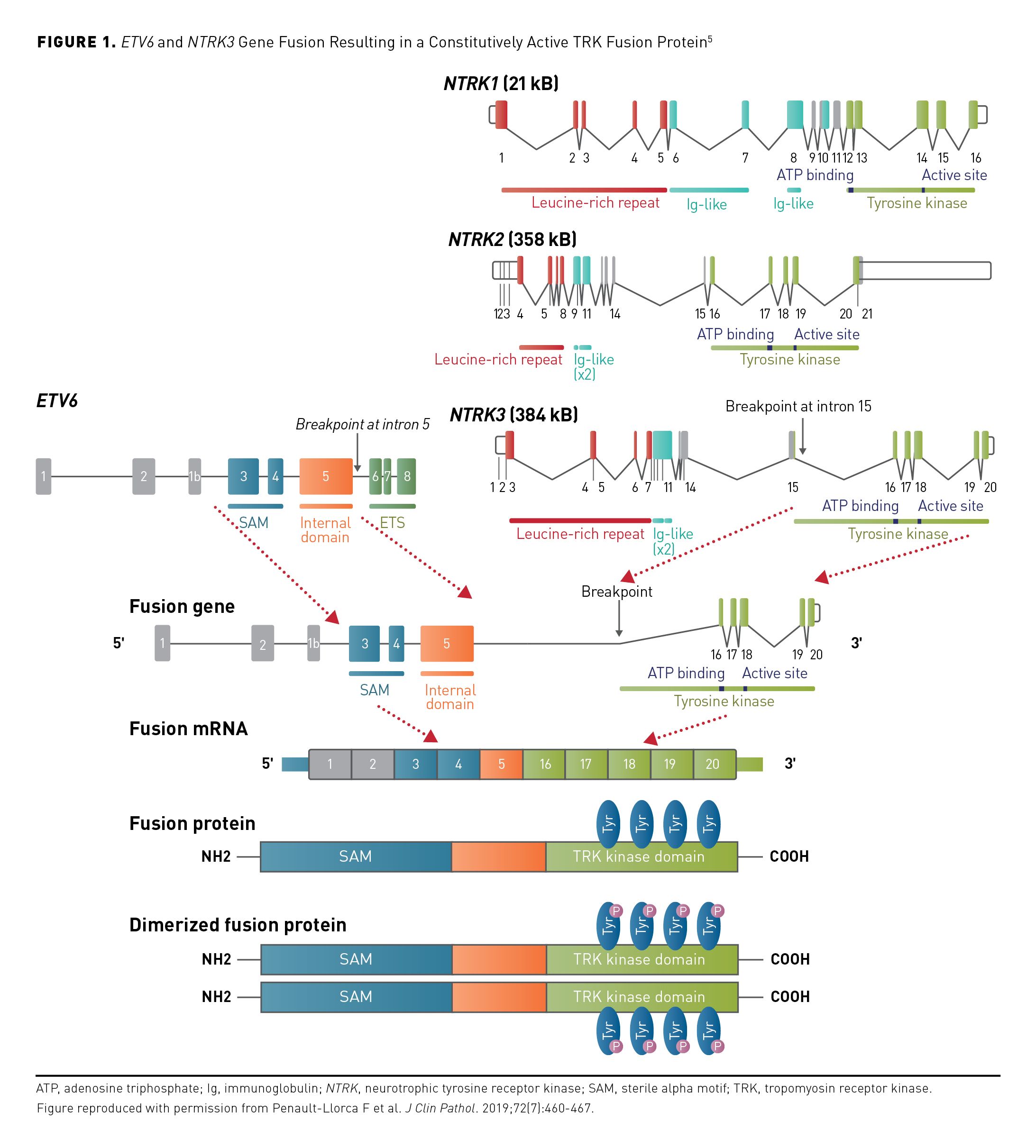
Approaches that may be used to detect NTRK gene fusions in clinical tissue samples, either indirectly or directly, include immunohistochemistry (IHC), fluorescence in situ hybridization (FISH), reverse transcriptase polymerase chain reaction (RT-PCR), and next-generation sequencing (NGS) of DNA and/or RNA (Table 1).5 IHC may be used to detect TRK overexpression as a surrogate for the presence of an NTRK gene fusion, and it is a useful screening tool in clinical settings with limited access to NGS platforms.5 IHC has proved to be a time- and tissue-efficient technique for routine screening10 and is attractive due to the low cost and universal availability compared with other technologies; however, some studies have reported challenges in the interpretation of IHC data.11 In particular, the specificity of IHC in central nervous system tumors can be limited due to high background TRK expression in neural tissues.12 As such, internal controls (eg, endothelial cells) and confirmatory testing using a molecular method are often recommended.5 FISH and RT-PCR, often used for testing tumor types with a high prevalence of NTRK gene fusions, are quick and cost-efficient but are able to detect only known, specific fusions.5,11 For FISH, a separate break-apart probe is required for each of the 3 NTRK genes, and the 5’ gene fusion cannot be identified using this method; furthermore, FISH does not confirm whether the fusion gene is transcribed.11 RT-PCR can be an alternative or complementary approach to FISH, detecting NTRK gene fusions using primers in the coding sequence of the 5’ fusion partner and the NTRK kinase domain. However, the large number of potential 5’ fusion partners may make a comprehensive multiplex RT-PCR assay challenging.11,13 Although DNA-based NGS allows for many genomic events to be interrogated, a disadvantage is that when gene translocations are detected, it is difficult to determine if these result in functionally expressed fusions. DNA-based NGS is also less accurate in detecting gene fusions that involve large intronic regions.11 RNA-based NGS is the preferred approach due to the diverse array of reported gene fusion partners in cancer. In addition to having the ability to detect multiple genomic alterations in a single assay, RNA-based NGS is a precise, specific, and highly sensitive testing modality.11,13 However, it can be limited by RNA quality. Moreover, NGS generally is not always accessible in a clinical setting and may require relatively long turnaround times.
Based on current technology, an optimal approach to use at initial diagnosis may be tissue DNA-based NGS, complemented with RNA-based NGS. For tumors such as salivary gland secretory carcinomas and infantile fibrosarcomas that have a high prevalence of NTRK gene fusions, more specific and limited techniques that have already been described may also be appropriate.
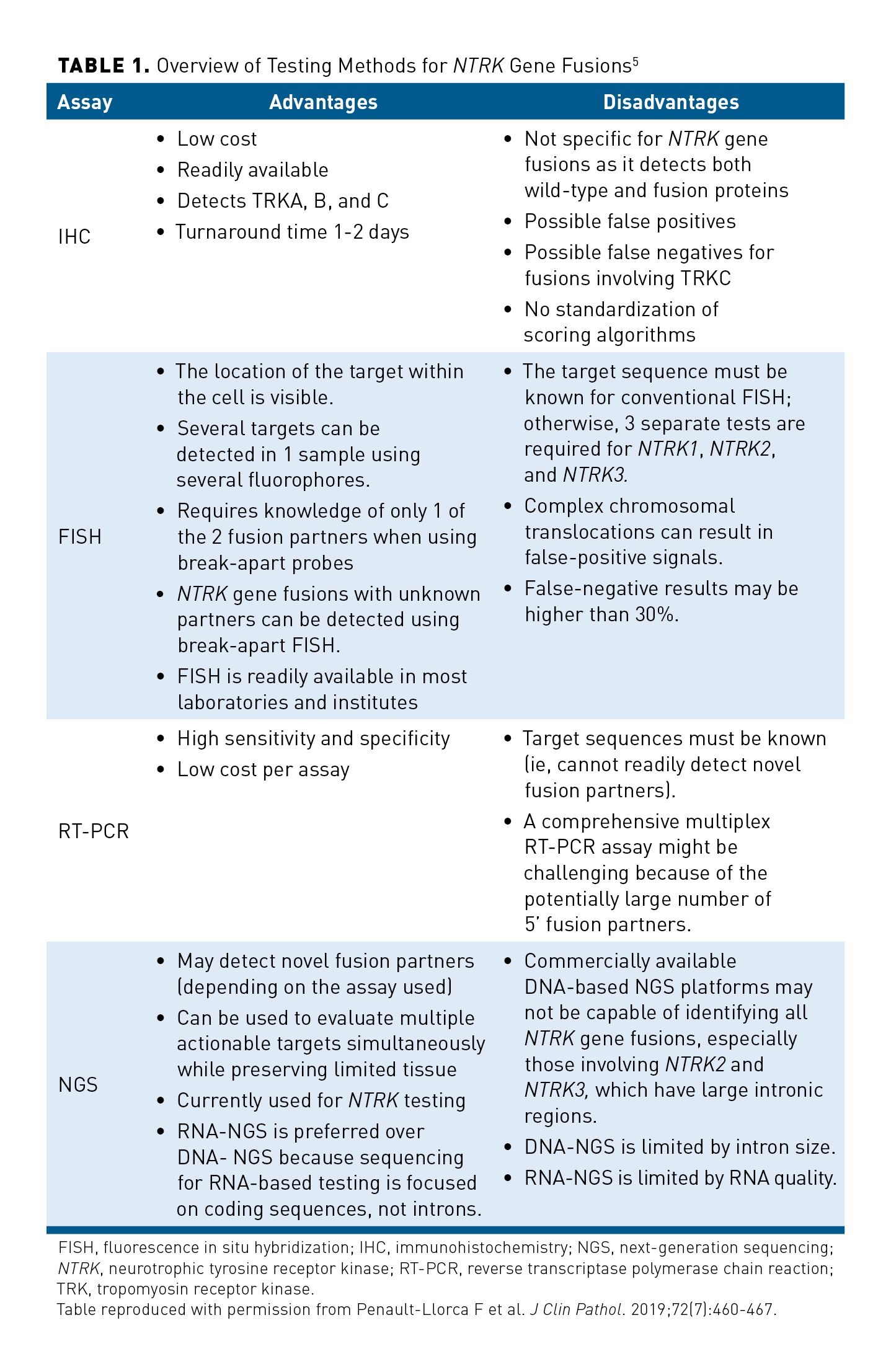
Epidemiology of NTRK Gene Fusions
NTRK gene fusions are oncogenic drivers of various adult and pediatric cancers.1,3,6,14,15 Incidence and prevalence data for NTRK gene fusions have only recently become available due to the increased availability of NGS and molecular testing techniques.1 Overall, solid tumors with NTRK gene fusions are rare. In 2018, the overall global incidence was estimated to be 0.52 per 100,000 persons, and the overall 5-year prevalence was estimated to be 1.52 per 100,000 persons, based on a systematic review and meta-analysis.16 NTRK gene fusions are found at very low frequencies in more prevalent tumor types, such as lung (0.2%; 95% CI, 0.1%-0.3%) and colorectal cancer (CRC) (0.3%; 95% CI, 0.2%-0.4%). However, they are common in several rare tumors, including infantile fibrosarcoma (90.6%; 95% CI, 67.4%-100%), secretory breast carcinoma (92.9%; 95% CI, 72.6%-100%), salivary gland secretory carcinoma (79.7%; 95% CI, 62.8%-96.5%), and congenital mesoblastic nephroma (21.5%; 95% CI, 13.1%-32.2%) (Table 2).16 NTRK gene fusion events appear to arise more commonly in the NTRK1 and NTRK3 genes, with the exception of primary brain tumors, in which fusions occur more commonly with NTRK2.1,17 NTRK gene fusions are also reported to occur more frequently in pediatric tumors than in adult tumors.18
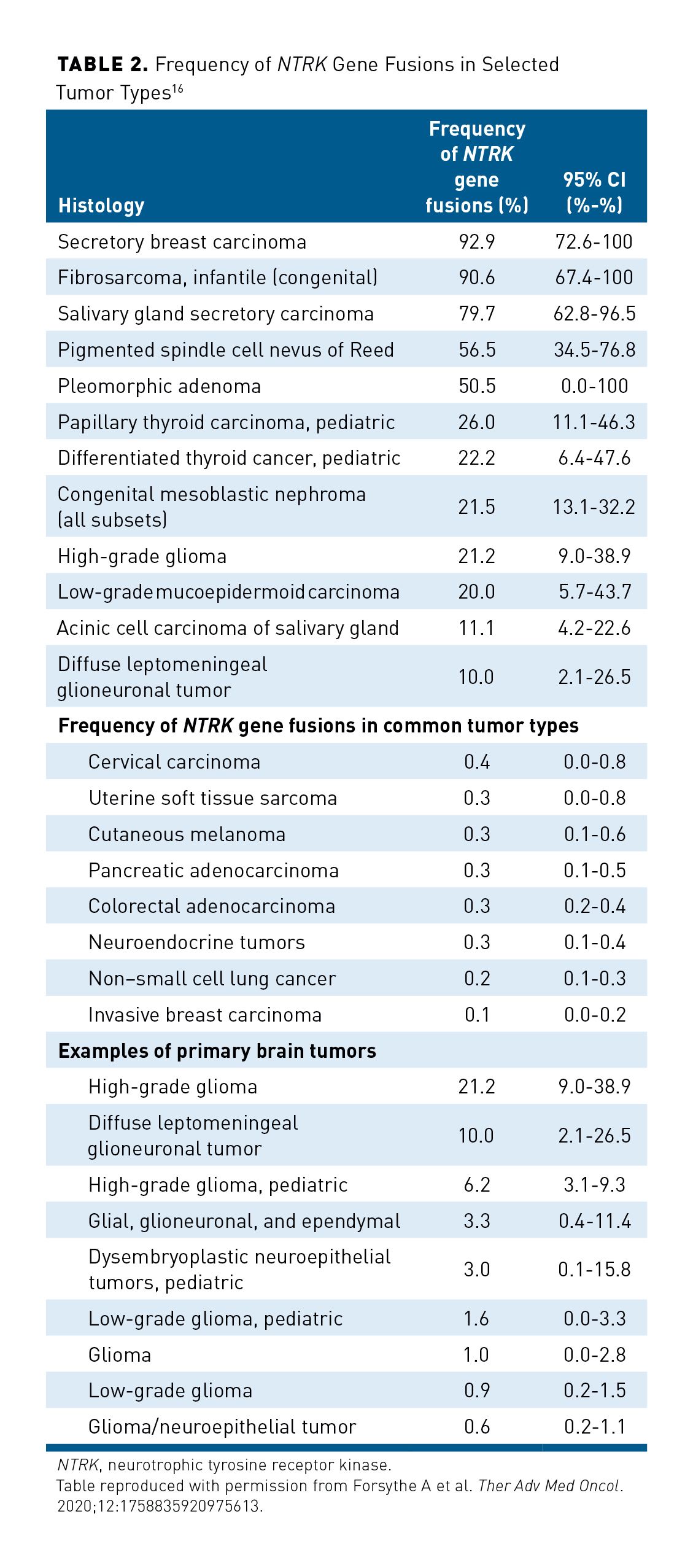
Real-world Evidence on TRK Fusion Cancer
Despite significant progress in treating TRK fusion cancer, there were, until recently, limited data on the demographics, genomic characteristics, and natural history of TRK fusion cancer compared with cancers not harboring NTRK gene fusions. This has partly been due to the rarity of TRK fusion cancer and the technical limitations and variation over time of detection methods.19,20 A number of real-world studies have been conducted to investigate the co-occurrence of other biomarkers and the overall prognosis of patients with TRK fusion cancer.
Co-occurrence of NTRK Gene Fusions and Other Actionable Biomarkers
Voyager-1 was a retrospective matched cohort study; it included information on patients with solid tumors gathered from a database of deidentified electronic health records from more than 280 cancer clinics, across approximately 800 US sites. Data included clinical and demographic characteristics, treatment patterns and outcomes, and genomic data such as somatic mutations, copy number alterations, genomic rearrangements, and microsatellite instability (MSI) status.20 Voyager-2 linked genomic data from the United Kingdom’s 100,000 Genomes Project with clinical data from UK cancer databases.21 Results of the 2 studies indicated that co-occurrence of oncogenic alterations in ALK, BRAF, ERBB2, EGFR, ROS1, and KRAS was uncommon in patients with NTRK gene fusions, supporting the hypothesis that NTRK gene fusions are the primary oncogenic drivers in tumors that harbor them, thus highlighting the importance of identifying patients with TRK fusion cancer. Furthermore, results of another study using a large real-world database of comprehensive genomic profiling data have demonstrated a lack of correlation between the presence of NTRK gene fusions and other clinically actionable biomarkers, including no co-occurrence with known oncogenic drivers in breast cancer and CRC.9 Given the low likelihood of other co-occurring oncogenic alterations in patients with NTRK gene fusions, treatment with a therapy that targets TRK is likely to provide the greatest benefit while avoiding off-target adverse events (AEs). These real-world database studies also showed that both high tumor mutational burden (TMB) and high MSI were more frequent in patients with CRC harboring NTRK gene fusions than in those who did not. Patients with CRC who test positive for high TMB and/or high MSI could therefore be considered an enriched population for NTRK gene fusions. These data align with previous reports that NTRK gene fusions occur more frequently in MSI-high CRC than in microsatellite stable CRC.22 Rosen et al also reported that NTRK gene fusions appear to be more common in tumors lacking canonical drivers, which, they concluded, may partially explain the tumor-agnostic efficacy of TRK inhibitors.19
Natural History of TRK Fusion Cancer
Several retrospective studies, including Voyager-1 and Voyager-2, have evaluated the prognostic impact of NTRK gene fusions. The results from these studies suggest that the prognosis of patients with and without NTRK gene fusions is similar, with some studies showing a trend (albeit not statistically significant) toward worse prognosis in patients with TRK fusion cancer.20,21,23-25 Therefore, the outcomes observed in patients with TRK fusion cancer receiving larotrectinib or entrectinib in clinical trials (discussed later) can be considered a direct result of TRK inhibition and not due to the patients’ inherent prognosis.
Treatment Options for TRK Fusion Cancer
Cancer treatment has historically been based on tumor histology and the tissue of origin.26 However, the introduction of precision oncology therapies has led to a paradigm shift, with drug development programs migrating away from histology-specific patient selection to biomarker-driven, tumor-agnostic enrichment, with a number of targeted therapies receiving tumor-agnostic regulatory approvals (eg, pembrolizumab in tumors of any type with high MSI).26,27 Larotrectinib and entrectinib are first-generation TRK inhibitors, approved for the treatment of TRK fusion cancer regardless of tumor type (Table 3).28,29 Several next-generation TRK inhibitors are already in clinical development.

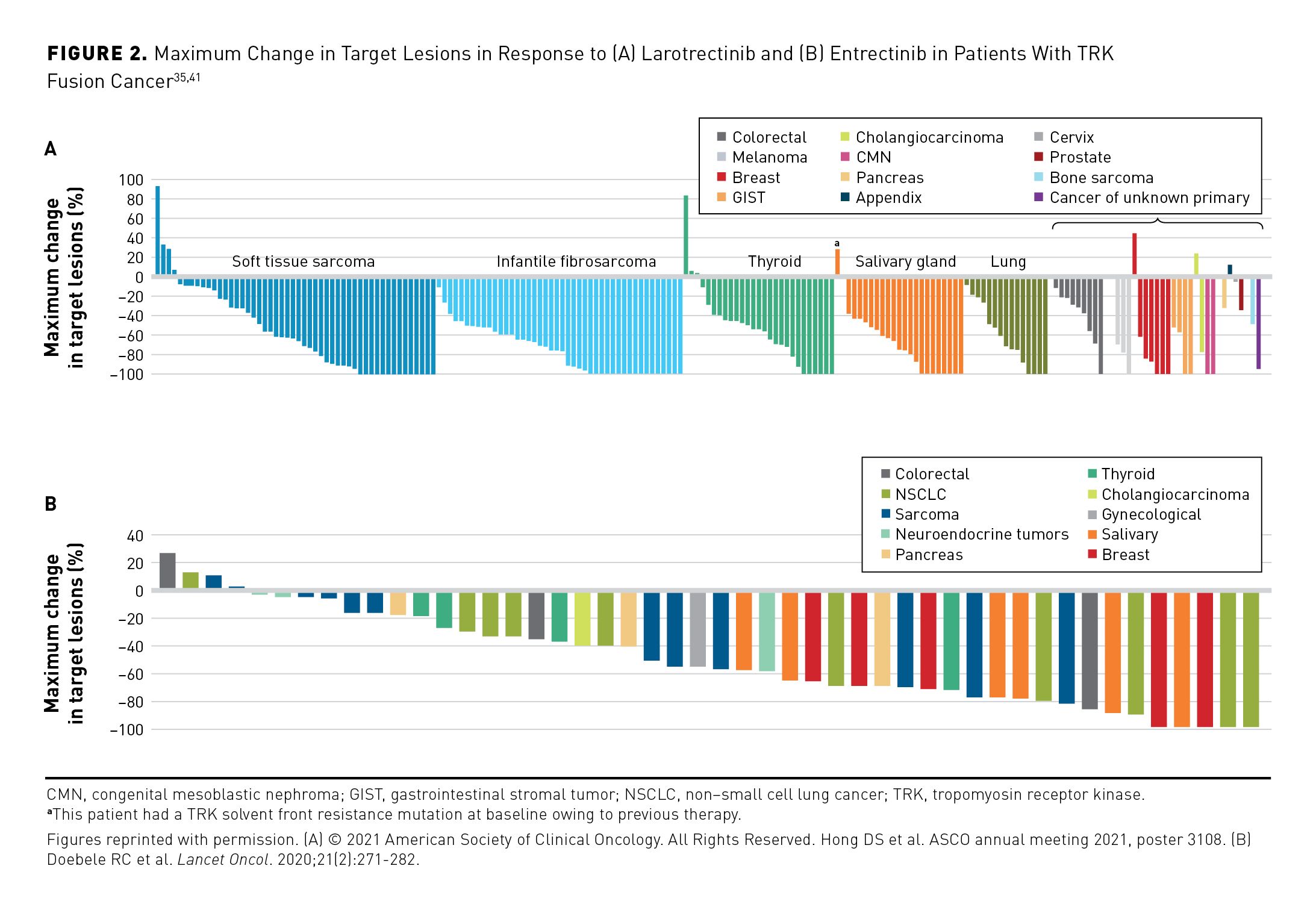
Overview of Larotrectinib
Larotrectinib is approved in more than 40 countries, including the United States, for adult and pediatric patients of all ages with TRK fusion cancer; it is available in both capsule and liquid formulations.3,28,30-32 It is a highly selective and potent inhibitor of TRKA (IC50 6.5 nM), TRKB (IC50 8.1 nM), and TRKC (IC50 10.6 nM), with high binding affinity to all 3 receptors (more than 100-fold higher selectivity against a panel of other kinases).33 It also inhibits the growth of cells and xenografts harboring NTRK gene fusions.26
The larotrectinib clinical development program is unique, as it encompassed patients across the age spectrum, including children aged as young as 1 month, and with a wide range of tumor types. The efficacy and safety of larotrectinib was evaluated in 3 phase 1/2 clinical studies in adults and children with TRK fusion cancer, who received doses of 100 mg (adults) or 100 mg/m2 (children) twice daily; these were an adult phase 1 study (NCT02122913) and the SCOUT (NCT02637687) and NAVIGATE (NCT02576431) trials.30,34 The objective response rate (ORR) from a pooled analysis of these 3 studies (N=55) was 75% (95% CI, 61%-85%) per independent review and 80% (95% CI, 67%-90%) per investigator assessment, with responses seen regardless of age, tumor type, specific NTRK gene, or fusion partner. At 1 year, 71% of the responses were ongoing and 55% of patients were progression free. The majority of AEs were grade 1/2, and there were no treatment discontinuations due to AEs.30 In an expanded data set of 218 patients with TRK fusion cancer, the investigator-assessed ORR was 75% (95% CI, 68%-81%)(Table 3),28,29 and median duration of response (DOR) was 49.3 months (95% CI, 27.3 to not estimable [NE]).35 Median progression-free survival (PFS) was 35.4 months (95% CI, 23.4-55.7), and median overall survival (OS) was not reached.35 Responses were seen with larotrectinib across the spectrum of tumor types included in the study (Figure 2A).35 The clinical benefits of larotrectinib are illustrated in Figure 336 and Figure 4. Treatment-related AEs (TRAEs) observed in larotrectinib clinical trials were predominantly of grade 1/2; grade 3/4 TRAEs were reported in 18% of patients, the most common of which were decreased neutrophil count (7%), increased alanine aminotransferase (3%), and increased aspartate aminotransferase (2%).
Patients across the age spectrum—from infants to the elderly—who received larotrectinib experienced rapid, sustained, and clinically meaningful improvements in quality of life (QOL); these improvements began within 2 months in more than two-thirds of patients.36,37 QOL scores for most patients were either maintained within or moved into the normal healthy range during larotrectinib treatment.36 Among patients with TRK fusion cancer who had QOL below normal at baseline and were treated with larotrectinib, 91% of adults and 67% of children 2 years or older moved into the normal/above-normal QOL range following treatment.37 Sustained QOL improvements occurred within 2 months in 69% of adults and 75% of children 2 years or older and were maintained for a median duration of 12.0 months (range, 1.7-20.3) and NE (range, 1.1-23.0), respectively. With improving survival rates and increasing long-term treatment, patient-reported QOL is a particularly relevant goal to strive for, allowing patients to live both longer and better.
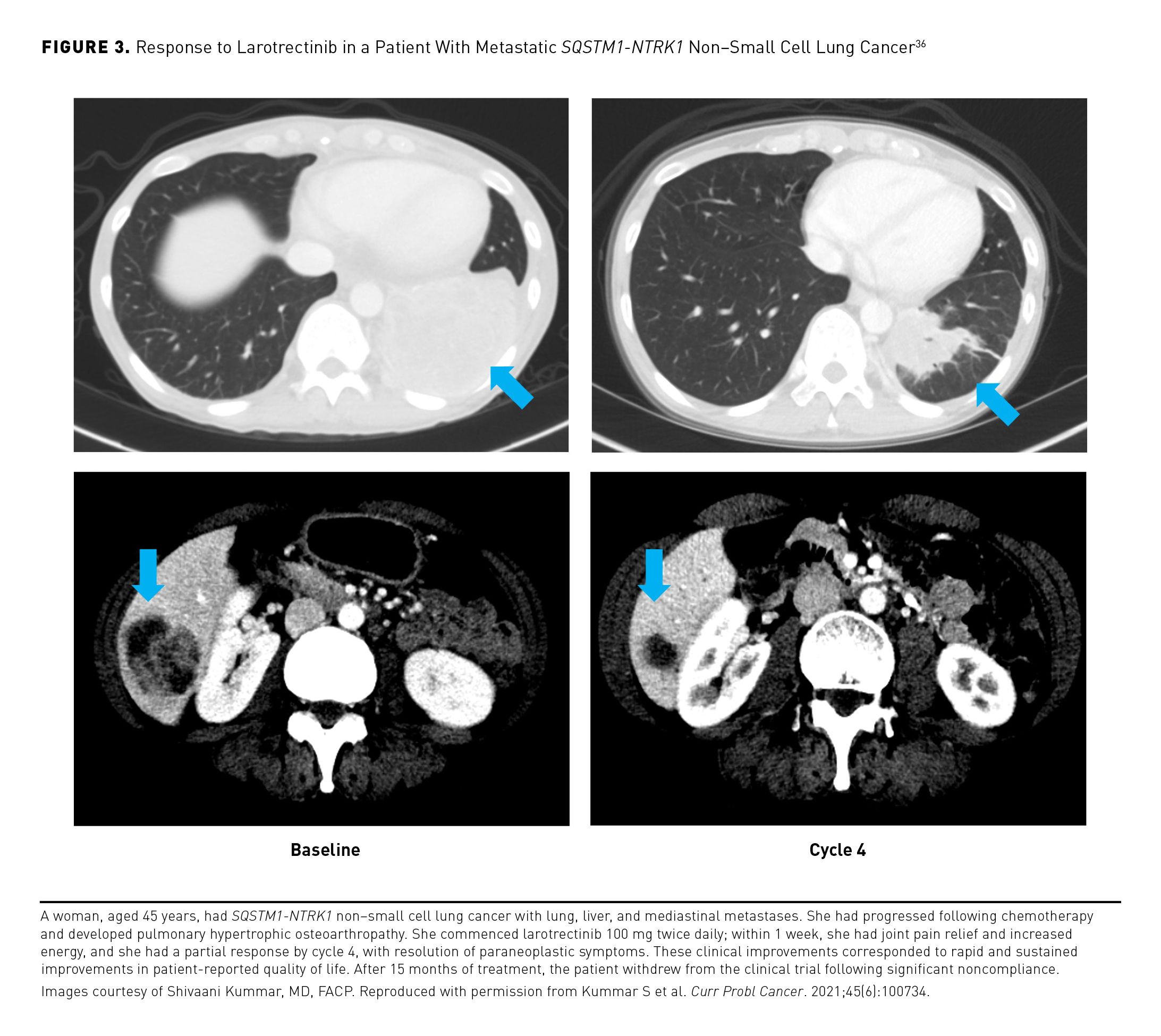
Overview of Entrectinib
Entrectinib, a multikinase inhibitor that targets TRK, ALK, ROS1, and JAK, is approved in the United States and the European Union for adult and pediatric patients 12 years or older with locally advanced or metastatic TRK fusion cancer; it is available in a capsule formulation.29,38,39
In vitro, entrectinib inhibits TRKA (IC50 2 nM), TRKB (IC50 0.57 nM), and TRKC (IC50 1.1 nM). It induces potent antiproliferative and apoptotic effects, as well as cell cycle arrest, in various tumor cell lines driven by NTRK gene fusion. We see inactivation of downstream AKT and ERK, in addition to antitumor activity and tumor regression, in mouse tumor models harboring NTRK fusions.40
The efficacy and safety of a once-daily 600-mg dose of entrectinib was evaluated in 4 phase 1/2 clinical trials that included patients with metastatic or locally advanced TRK fusion cancer: ALKA-372-001 (EudraCT 2012–000148–88), STARTRK-1 (NCT02097810), STARTRK-2 (NCT02568267), and STARTRK-NG (NCT02650401). In an initial data set of 54 patients, 31 (57%; 95% CI, 43.2%-70.8%) had an objective response (Table 328).29,41 Median DOR was 10 months (95% CI, 7.1-NE), median PFS was 11 months (95% CI, 8.0-14.9), and median OS was 21 months (95% CI, 14.9-NE). The most common grade 3/4 TRAEs were increased weight (10%) and anemia (12%), and the most common serious TRAEs were nervous system disorders (4%). Treatment discontinuation due to TRAEs occurred in 4% of patients.41 In an expanded data set of 121 patients, ORR was 61%, median DOR was 20.0 months, median PFS was 13.8 months, and median OS was 33.8 months.42
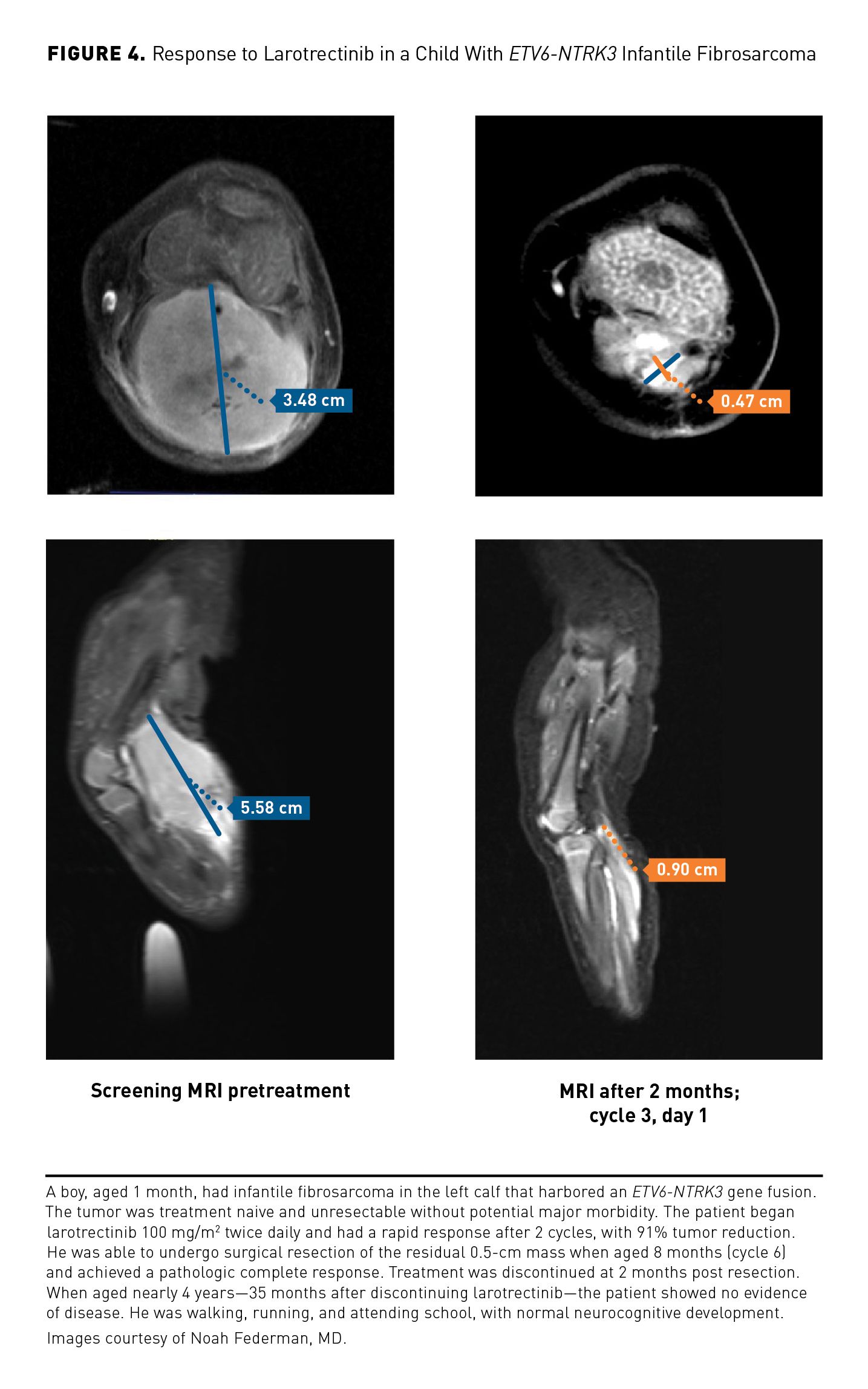
In terms of patient-reported QOL, global health status remained stable in patients with TRK fusion cancer who were treated with entrectinib during the phase 2 basket trial STARTRK-2.43 Trends toward clinical improvement were seen for role and physical functioning during treatment, and treatment- and tumor-related symptoms (eg, nausea and fatigue) remained generally stable or trended toward clinically meaningful improvement.
Next-Generation TRK Inhibitors
Acquired resistance to first-generation TRK inhibitors can arise from secondary mutations within the NTRK gene kinase domain (on-target resistance), including solvent-front substitutions and gatekeeper mutations, or activation of bypass signaling mechanisms (off-target resistance). Next-generation agents are being developed to address on-target resistance that is mediated by such emergent kinase domain mutations, while maintaining potency against wild-type TRK fusion proteins. The most advanced agents, selitrectinib and repotrectinib, are in phase 1/2 development, and preliminary data suggest encouraging clinical activity. Among patients who had progressed or were intolerant to at least 1 prior TRK inhibitor, selitrectinib treatment resulted in a 34% ORR.44 The ORR was greater (45%) among patients with confirmed TRK kinase domain mutations. Although some data show that repotrectinib, a ROS1/TRK/ALK tyrosine kinase inhibitor, can overcome acquired resistance to prior TRK inhibition, evidence remains limited so far, generally relating only to single patients.45-47 Several other next-generation TRK inhibitors are under early investigation in patients with NTRK gene fusions; these include multikinase inhibitors (cabozantinib, merestinib, and sitravatinib) and the ROS1/TRK tyrosine kinase inhibitor taletrectinib (DS-6051b).48,49
Clinical Practice Recommendations for TRK Fusion Cancer
Integration of NTRK gene fusion testing into routine clinical practice and selection of the optimal testing modality is challenging. Several guidelines have been published that make recommendations on both the diagnosis and treatment of TRK fusion cancer.
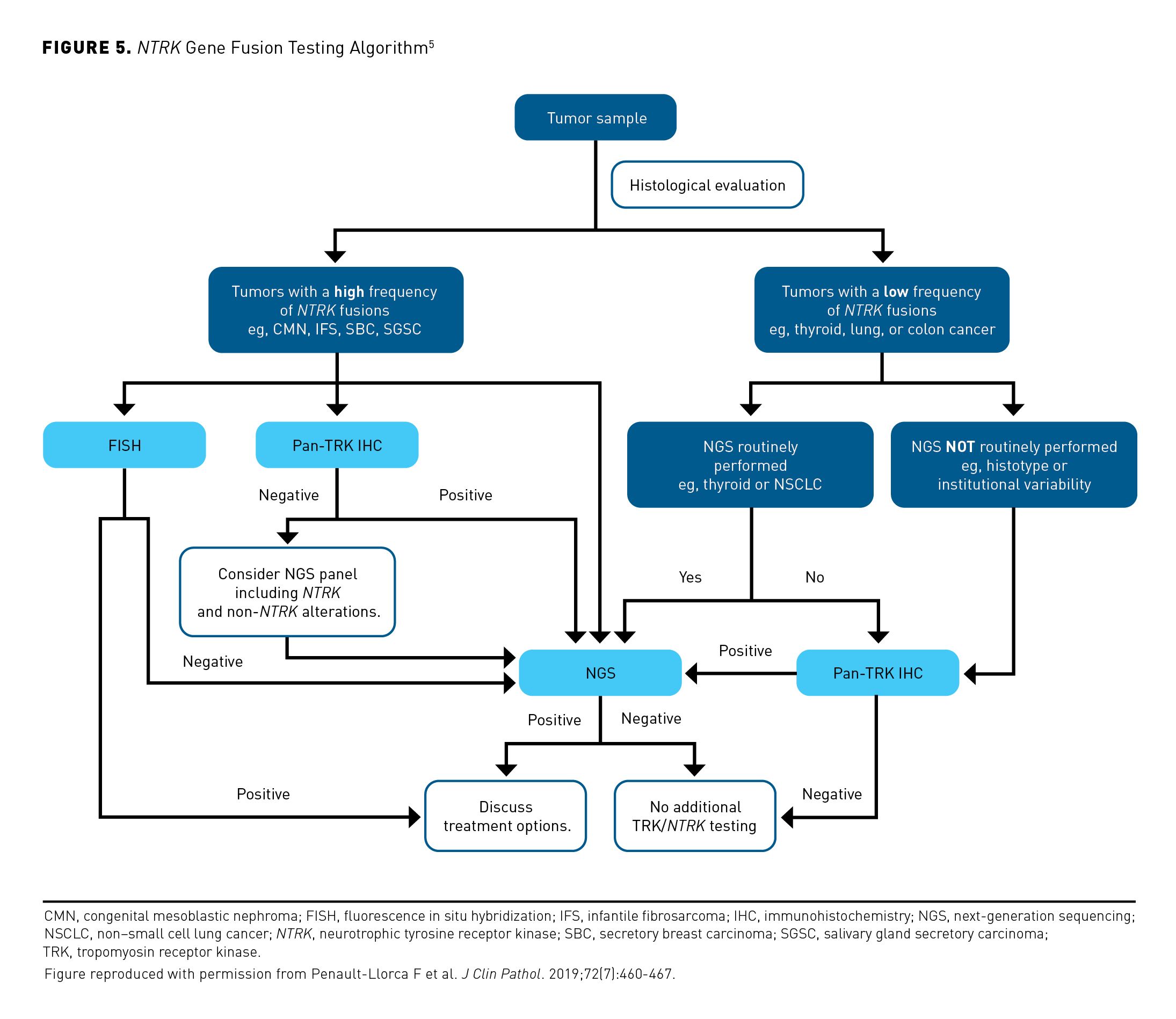
Diagnosis
The European Society for Medical Oncology (ESMO) states that the development of optimal approaches to detect human cancers that harbor activating NTRK1/2/3 fusions is crucial to the administration of TRK inhibitors. In tumors in which NTRK gene fusions are highly recurrent, FISH, RT-PCR, or RNA-based NGS is recommended, whereas RNA-based NGS or IHC screening followed by sequencing is considered appropriate for testing an unselected population where fusions are uncommon.50 ESMO guidelines also advise that the choice of assay and final diagnosis should consider the resources and clinical context.50
Penault-Llorca et al proposed a screening algorithm for identifying patients with TRK fusion cancer in clinical practice, in order to guide treatment decisions.5 The algorithm categorizes tumors based on the incidence of NTRK gene fusions, and it incorporates the strengths and availability of each testing modality (Figure 5).5 In tumors with a high frequency of NTRK gene fusions, FISH or pan-TRK IHC (if FISH is unavailable) is recommended, with confirmation by targeted NGS in patients with positive IHC.5 The pattern of TRK staining by IHC can inform the selection of confirmatory test, as tumors harboring NTRK1 rearrangements typically show strong, diffuse cytoplasmic staining.5 In contrast, tumors harboring NTRK3 rearrangements may have focal nuclear staining but weaker expression.5 Negative results from FISH or IHC should also be confirmed by NGS. In solid tumors that often harbor various gene fusions, but with a low frequency of NTRK gene fusions (5%-25%), an NGS panel that includes NTRK fusions is recommended. Lastly, for tumors with a very low frequency of NTRK gene fusions (< 5%) but in which molecular screening is common, inclusion of NTRK genes in routine NGS analysis is recommended. If NGS is not available or is not routinely utilized, pan-TRK IHC should be used for screening, followed by NGS confirmation of positive results, with RNA-based NGS being the preferred modality. Pan-TRK IHC alone is not sufficient to identify TRK fusion cancer; this is because IHC detects both wild-type and fusion TRK proteins, is associated with false-positive results, and will also detect TRK overexpression resulting from other NTRK gene alterations, such as amplification, which may not be primary oncogenic drivers.
Treatment
Larotrectinib and entrectinib are increasingly being integrated into national and international clinical practice guidelines. Clinical practice guidelines from the American Society of Clinical Oncology and ESMO recommend both agents for the treatment of progressive metastatic solid tumors with NTRK fusions, including non–small cell lung cancer, breast cancer, soft tissue sarcoma, salivary gland cancer, and thyroid cancer.51-56
Summary
There has recently been important progress in the treatment of cancer based on tumor genomics rather than the tissue of origin. In the case of TRK fusion cancer, the inhibition of the TRK signaling pathway has been found to be an effective approach for cancer treatment in adult and pediatric patients. Although NTRK gene fusions are generally rare, they can be found in very prevalent tumors. As such, identifying patients with TRK fusion cancer allows them to potentially benefit from TRK inhibitors, which are highly effective and well tolerated. The therapeutic benefit to these patients outweighs the difficulties of identifying NTRK gene fusions. As such, NTRK gene fusion testing should be considered in patients with advanced solid tumors, regardless of tumor histology. A number of cancer clinical guidelines include recommendations for NTRK gene fusion testing, and testing algorithms have been developed for identifying patients with TRK fusion cancer in clinical practice. The long-term effects of TRK inhibition in pediatric and adolescent patients are currently unknown, but they warrant attention due to the role of TRK signaling in the development and functioning of the nervous system. Resistance to first-generation inhibitor treatment can also arise; therefore, the development of next-generation TRK inhibitors is under way.26
Acknowledgments
Medical writing support was provided by Michael Sheldon, PhD, and editorial support was provided by George Chappell, MSc, both of Scion (London, UK), supported by Bayer according to Good Publication Practice guidelines. Bayer was involved in fact-checking information provided in the manuscript. However, ultimate responsibility for opinions, conclusions, and data interpretation lies with the authors.
Author affiliations: Thomas Jefferson University Hospitals (MSB); University of Washington (JJC, SDS); University of California, Los Angeles (NF); Institut Bergonié (AI); Oregon Health and Science University (SK); Rigshospitalet (UL); Fred Hutchinson Cancer Research Center (SDS).
Funding source: This article was published as part of a supplement that was financially supported by Bayer HealthCare Pharmaceuticals, Inc. Noah Federman’s research is supported by NIH National Center for Advancing Translational Science (NCATS) UCLA Clinical & Translational Science Institute (CTSI) Grant Number UL1TR001881.
Author disclosures: Dr Brose, Dr Carlson, Dr Federman, Dr Kummar, Dr Lassen, and Dr Sullivan have been part of consultancies or paid advisory boards with Bayer. Dr Brose and Dr Federman have been part of consultancies or paid advisory boards with Loxo Oncology. Dr Brose has also been part of consultancies or paid advisory boards with Genentech, AstraZeneca, and Eli Lilly and Company. Dr Brose has received honoraria from Clinical Care Options, Medscape, OncLive®, and PeerView. Dr Brose has also disclosed that research support to the University of Pennsylvania School of Pharmacy has been provided by Bayer, Loxo Oncology, Genentech, Eisai, Blueprint Medicines, Eli Lilly and Company, and Novartis. Dr Carlson has received honoraria from Adaptive Biotechnologies. Dr Federman has received lecture fees for speaking at the invitation of Bayer and received patent royalties from NanoValent Pharmaceuticals, Inc. Dr Federman has also disclosed that he holds stock in the for-profit health care companies Genmab, Reata Pharmaceuticals, and bluebird bio, Inc. Dr Italiano and Dr Lassen have both received grants from Roche. Dr Italiano has also received grants from AstraZeneca, Bayer, Merck, Merck Sharp & Dohme, and PharmaMar. Dr Italiano has disclosed that he has received honoraria from Bayer, Daiichi Sankyo, Epizyme, Ipsen, Roche, and SpringWorks Therapeutics. Dr Kummar has been part of consultancies or paid advisory boards with Boehringer Ingelheim, SpringWorks Therapeutics, Gilead, EcoR1 Capital, Seagen, Mundipharma, Mirati Therapeutics, Genome & Company, and Harbour Biomed. Dr Kummar has also disclosed that she is the cofounder and is an equity holder for PathomIQ. Dr Kummar has also disclosed that she is the editor-in-chief of Current Problems in Cancer (Elsevier) and that her spouse is a scientific adviser for Cadila Pharmaceuticals Ltd and is the founder of Arxeon Inc. Dr Lassen has also reported that he has been part of consultancies or paid advisory boards with Pfizer and Novartis. Dr Lassen has also received grants from Bristol Myers Squibb, GlaxoSmithKline, and Pfizer.
Authorship information: Analysis and interpretation of data (SK, AI, MSB, JJC, SDS, UL, NF); drafting of the manuscript (SK, AI, MSB, JJC, SDS, UL, NF); critical revision of the manuscript for important intellectual content (SK, AI, MSB, JJC, SDS, UL, NF).
Address correspondence to: Shivaani Kummar, MD, FACP; kummar@ohsu.edu
REFERENCES
1. Amatu A, Sartore-Bianchi A, Bencardino K, Pizzutilo EG, Tosi F, Siena S. Tropomyosin receptor kinase (TRK) biology and the role of NTRK gene fusions in cancer. Ann Oncol. 2019;30(suppl 8):viii5-viii15. doi:10.1093/annonc/mdz383
2. Reichardt LF. Neurotrophin-regulated signalling pathways. Philos Trans R Soc Lond B Biol Sci. 2006;361(1473):1545-1564. doi:10.1098/rstb.2006.1894
3. Cocco E, Scaltriti M, Drilon A. NTRK fusion–positive cancers and TRK inhibitor therapy. Nat Rev Clin Oncol. 2018;15(12):731-747. doi:10.1038/s41571-018-0113-0
4. Vaishnavi A, Le AT, Doebele RC. TRKing down an old oncogene in a new era of targeted therapy. Cancer Discov. 2015;5(1):25-34. doi:10.1158/2159-8290.CD-14-0765
5. Penault-Llorca F, Rudzinski ER, Sepulveda AR. Testing algorithm for identification of patients with TRK fusion cancer. J Clin Pathol. 2019;72(7):460-467. doi:10.1136/jclinpath-2018-205679
6. Skálová A, Vanecek T, Sima R, et al. Mammary analogue secretory carcinoma of salivary glands, containing the ETV6-NTRK3 fusion gene: a hitherto undescribed salivary gland tumor entity. Am J Surg Pathol. 2010;34(5):599-608. doi:10.1097/PAS.0b013e3181d9efc
7. Tognon C, Knezevich SR, Huntsman D, et al. Expression of the ETV6-NTRK3 gene fusion as a primary event in human secretory breast carcinoma. Cancer Cell. 2002;2(5):367-376. doi:10.1016/s1535- 6108(02)00180-0
8. Bourgeois JM, Knezevich SR, Mathers JA, Sorensen PH. Molecular detection of the ETV6-NTRK3 gene fusion differentiates congenital fibrosarcoma from other childhood spindle cell tumors. Am J Surg Pathol. 2000;24(7):937-946. doi:10.1097/00000478-200007000-00005
9. Westphalen CB, Krebs MG, Le Tourneau C, et al. Genomic context of NTRK1/2/3 fusion-positive tumours from a large real-world population. NPJ Precis Oncol. 2021;5(1):69. doi:10.1038/s41698-021-00206-y
10. Hechtman JF, Benayed R, Hyman DM, et al. Pan-Trk immunohistochemistry is an efficient and reliable screen for the detection of NTRK fusions. Am J Surg Pathol. 2017;41(11):1547-1551. doi10.1097/ PAS.0000000000000911
11. Solomon JP, Benayed R, Hechtman JF, Ladanyi M. Identifying patients with NTRK fusion cancer. Ann Oncol. 2019;30(suppl 8):viii16-viii22. doi:10.1093/annonc/mdz384
12. Gambella A, Senetta R, Collemi G, et al. NTRK fusions in central nervous system tumors: a rare, but worthy target. Int J Mol Sci. 2020;21(3):753. doi:10.3390/ijms21030753
13. Beadling C, Wald AI, Warrick A, et al. A multiplexed amplicon approach for detecting gene fusions by next-generation sequencing. J Mol Diagn. 2016;18(2):165-175. doi:10.1016/j.jmoldx.2015.10.002
14. Shukla N, Roberts SS, Baki MO, et al. Successful targeted therapy of refractory pediatric ETV6-NTRK3 fusion–positive secretory breast carcinoma. JCO Precis Oncol. 2017;2017:PO.17.00034. doi:10.1200/PO.17.00034
15. Nagasubramanian R, Wei J, Gordon P, Rastatter JC, Cox MC, Pappo A. Infantile fibrosarcoma with NTRK3-ETV6 fusion successfully treated with the tropomyosin-related kinase inhibitor LOXO-101. Pediatr Blood Cancer. 2016;63(8):1468-1470. doi:10.1002/pbc.26026
16. Forsythe A, Zhang W, Strauss UP, Fellous M, Korei M, Keating K. A systematic review and meta-analysis of neurotrophic tyrosine receptor kinase gene fusion frequencies in solid tumors. Ther Adv Med Oncol. 2020;12:1758835920975613. doi:10.1177/1758835920975613
17. Kummar S, Lassen UN. TRK inhibition: a new tumor-agnostic treatment strategy. Targeted Oncol. 2018;13(5):545-556. doi:10.1007/s11523-018-0590-1
18. Zhao X, Kotch C, Fox E, et al. NTRK fusions identified in pediatric tumors: the frequency, fusion partners, and clinical outcome. JCO Precis Oncol. 2021;1:PO.20.00250. doi:10.1200/PO.20.00250
19. Rosen EY, Goldman DA, Hechtman JF, et al. TRK fusions are enriched in cancers with uncommon histologies and the absence of canonical driver mutations. Clin Cancer Res. 2020;26(7):1624-1632. doi:10.1158/1078-0432.CCR-19-3165
20. Bazhenova L, Lokker A, Snider J, et al. TRK fusion cancer: patient characteristics and survival analysis in the real-world setting. Targeted Oncol. 2021;16(3):389-399. doi:10.1007/s11523-021-00815-4
21. Bridgewater J, Jiao X, Parimi M, et al. Abstract 394: prognosis and molecular characteristics of patients with TRK fusion cancer in the 100,000 Genomes Project. Cancer Res. 2021;81(suppl 13). doi:10.1158/1538-7445.AM2021-394
22. Pietrantonio F, Di Nicolantonio F, Schrock AB, et al. ALK, ROS1, and NTRK rearrangements in metastatic colorectal cancer. J Natl Cancer Inst. 2017;109(12). doi:10.1093/jnci/djx089
23. Demetri GD, Peters S, Hibbar DP, et al. 100P – characteristics and outcomes of patients (pts) with NTRK fusion–positive (NTRK+) metastatic / locally advanced (LA) solid tumours receiving non-TRK inhibitor (TRKi) standard of care (SoC), and prognostic value of NTRK fusions in clinical practice. Ann Oncol. 2021;32(suppl 5):S399. doi:10.1016/annonc/annonc686
24. Zhu L, Hobbs B, Roszik J, Holla V, Hong DS. Investigating the natural history and prognostic nature of NTRK gene fusions in solid tumors. Invest New Drugs. Published online August 2, 2021. doi:10.1007/ s10637-021-01157-8
25. Santi I, Vellekoop H, Huygens S, Rutten-van Molken M, Versteegh M. 105P – prognostic value of the NTRK fusion biomarker in the Netherlands. Ann Oncol. 2021;32(suppl 5):S401-S402. doi:10.1016/j. annonc.2021.08.385
26. Drilon A. TRK inhibitors in TRK fusion-positive cancers. Ann Oncol. 2019;30(suppl 8):viii23-viii30. doi:10.1093/annonc/mdz282
27. Le DT, Uram JN, Wang H, et al. PD-1 blockade in tumors with mismatch-repair deficiency. N Engl J Med. 2015;372(26):2509-2520. doi:10.1056/NEJMoa1500596
28. Vitrakvi. Prescribing information. Bayer HealthCare Pharmaceuticals; updated March 2021. Accessed November 15, 2021. https://www.accessdata.fda.gov/drugsatfda_docs/label/2021/210861s006lbl.pdf
29. Rozlytrek. Prescribing information. Genentech; updated November 2021. Accessed November 15, 2021. https://www.gene.com/download/pdf/rozlytrek_prescribing.pdf
30. Drilon A, Laetsch TW, Kummar S, et al. Efficacy of larotrectinib in TRK fusion–positive cancers in adults and children. N Engl J Med. 2018;378(8):731-739. doi:10.1056/NEJMoa1714448
31. Bayer AG. Vitrakvi: annex I – summary of product characteristics. European Medicines Agency; updated May 2021. Accessed October 1, 2021. https://www.ema.europa.eu/en/documents/product-information/ vitrakvi-epar-product-information_en.pdf
32. Precision oncology treatment larotrectinib submitted for marketing authorization in China. News release. Bayer Global; May 25, 2021. Accessed October 1, 2021. https://media.bayer.com/baynews/ baynews.nsf/id/20E13B140081FE60C12586DC003CE87C?open&ref=irrefndcd
33. Ghilardi JR, Freeman KT, Jimenez-Andrade JM, et al. Administration of a tropomyosin receptor kinase inhibitor attenuates sarcoma-induced nerve sprouting, neuroma formation and bone cancer pain. Mol Pain. 2010;6:87. doi:10.1186/1744-8069-6-87
34. Hong DS, DuBois SG, Kummar S, et al. Larotrectinib in patients with TRK fusion–positive solid tumours: a pooled analysis of three phase 1/2 clinical trials. Lancet Oncol. 2020;21(4):531-540. doi:10.1016/S1470-2045(19)30856-3
35. Hong DS, Shen L, Van Tilburg CM, et al. Long-term efficacy and safety of larotrectinib in an integrated dataset of patients with TRK fusion cancer. J Clin Oncol. 2021;39(suppl 15):abstr 3108. doi:10.1200/ JCO.2021.39.15_suppl.3108
36. Kummar S, Berlin J, Mascarenhas L, et al. Quality of life in adult and pediatric patients with tropomyosin receptor kinase fusion cancer receiving larotrectinib. Curr Probl Cancer. Published online April 2, 2021. doi:10.1016/j.currproblcancer.2021.100734
37. Kummar S, Van Tilburg CM, Albert CM, et al. Quality of life of adults and children with TRK fusion cancer treated with larotrectinib compared to the general population. J Clin Oncol. 2020;38(suppl 15):abstr 3614. doi:10.1200/JCO.2020.38.15_suppl.3614
38. Menichincheri M, Ardini E, Magnaghi P, et al. Discovery of entrectinib: a new 3-aminoindazole as a potent anaplastic lymphoma kinase (ALK), c-ros oncogene 1 kinase (ROS1), and pan-tropomyosin receptor kinases (Pan-TRKs) inhibitor. J Med Chem. 2016;59(7):3392-3408. doi:10.1021/acs.jmedchem.6b00064
39. Roche Pharma AG. Rozlytrek: annex I – summary of product characteristics. European Medicines Agency; updated September 2021. Accessed October 1, 2021. https://www.ema.europa.eu/en/documents/ product-information/rozlytrek-epar-product-information_en.pdf
40. Liu D, Offin M, Harnicar S, Li BT, Drilon A. Entrectinib: an orally available, selective tyrosine kinase inhibitor for the treatment of NTRK, ROS1, and ALK fusion–positive solid tumors. Ther Clin Risk Manag. 2018;14:1247-1252. doi:10.2147/TCRM.S14738
41. Doebele RC, Drilon A, Paz-Ares L, et al; trial investigators. Entrectinib in patients with advanced or metastatic NTRK fusion-positive solid tumours: integrated analysis of three phase 1-2 trials. Lancet Oncol. 2020;21(2):271-282. doi:10.1016/S1470-2045(19)30691-6
42. Bazhenova L, Liu SV, Lin JJ, et al. 533P – efficacy and safety of entrectinib in patients with locally advanced/metastatic NTRK fusion–positive (NTRK-fp) solid tumours. Ann Oncol. 2021;32(suppl 5):S598-S599. doi:10.1016/annonc/annonc699
43. Paz-Ares L, Barlesi F, Siena S, et al. Patient-reported outcomes from STARTRK-2: a global phase II basket study of entrectinib for ROS1 fusion–positive non–small-cell lung cancer and NTRK fusion–positive solid tumours. ESMO Open. 2021;6(3):100113. doi:10.1016/j.esmoop.2021.100113
44. Hyman D, Kummar S, Farago A, et al. Phase I and expanded access experience of LOXO-195 (BAY 2731954), a selective next-generation TRK inhibitor (TRKi). Cancer Res. 2019;79(suppl 13):abstr CT127. doi:10/1158/1538-7445.AM2019-CT127
45. Drilon A, Ou S-HI, Cho BC, et al. Repotrectinib (TPX-0005) is a next-generation ROS1/TRK/ALK inhibitor that potently inhibits ROS1/TRK/ALK solvent-front mutations. Cancer Discov. 2018;8(10):1227-1236. doi:10.1158/2159-8290.CD-18-0484
46. Drilon AEDC, Zhai D, Deng W, et al. Abstract 442: repotrectinib, a next generation TRK inhibitor, overcomes TRK resistance mutations including solvent front, gatekeeper and compound mutations. Presented at: American Association for Cancer Research Annual Meeting; March 29-April 3, 2019; Atlanta, GA.
47. Murray BW, Rogers E, Zhai D, et al. Molecular characteristics of repotrectinib that enable potent inhibition of TRK fusion proteins and resistant mutations. Mol Cancer Ther. Published online October 8, 2021. doi:10.1158/1535-7163.MCT-21-0632
48. Chu P, Batson S, Hodgson M, Mitchell CR, Steenrod A. Systematic review of neurotrophic tropomyosin–related kinase inhibition as a tumor-agnostic management strategy. Future Oncol. 2020;16(4):61-74. doi:10.2217/fon-2019-0534
49. Papadopoulos KP, Borazanci E, Shaw AT, et al. U.S. phase I first-in-human study of taletrectinib (DS-6051b/AB-106), a ROS1/TRK inhibitor, in patients with advanced solid tumors. Clin Cancer Res. 2020;26(18):4785-4794. doi:10.1158/1078-0432.CCR-20-1630
50. Marchiò C, Scaltriti M, Ladanyi M, et al. ESMO recommendations on the standard methods to detect NTRK fusions in daily practice and clinical research. Ann Oncol. 2019;30(9):1417-1427. doi:10.1093/annonc/mdz204
51. Cardoso F, Paluch-Shimon S, Senkus E, et al. 5th ESO-ESMO International Consensus Guidelines for advanced breast cancer (ABC 5). Ann Oncol. 2020;31(12):1623-1649. doi:10.1016/j.annonc.2020.09.010
52. Filetti S, Durante C, Hartl D, et al; ESMO Guidelines Committee. Thyroid cancer: ESMO Clinical Practice Guidelines for diagnosis, treatment and follow-up. Ann Oncol. 2019;30(12):1856-1883. doi:10.1093/annonc/mdz400
53. Planchard D, Popat S, Kerr K, et al; ESMO Guidelines Committee. Metastatic non-small cell lung cancer: ESMO Clinical Practice Guidelines for diagnosis, treatment and follow-up. Ann Oncol. 2018;29(suppl 4):iv192-iv237. doi:10.1093/annonc/mdy275
54. Geiger JL, Ismaila N, Beadle B, et al. Management of salivary gland malignancy: ASCO Guideline. J Clin Oncol. 2021;39(17):1909-1941. doi:10.1200/JCO.21.00449
55. Hanna NH, Robinson AG, Temin S, et al. Therapy for stage IV non–small-cell lung cancer with driver alterations: ASCO and OH (CCO) Joint Guideline update. J Clin Oncol. 2021;39(9):1040-1091. doi:10.1200/ JCO.20.03570
56. Gronchi A, Miah AB, Dei Tos AP, et al; ESMO Guidelines Committee, EURACAN and GENTURIS. Soft tissue and visceral sarcomas: ESMO-EURACAN-GENTURIS Clinical Practice Guidelines for diagnosis, treatment and follow-up. Ann Oncol. 2021;32(11):1348-1365. doi:10.1016/j.annonc.2021.07.006
